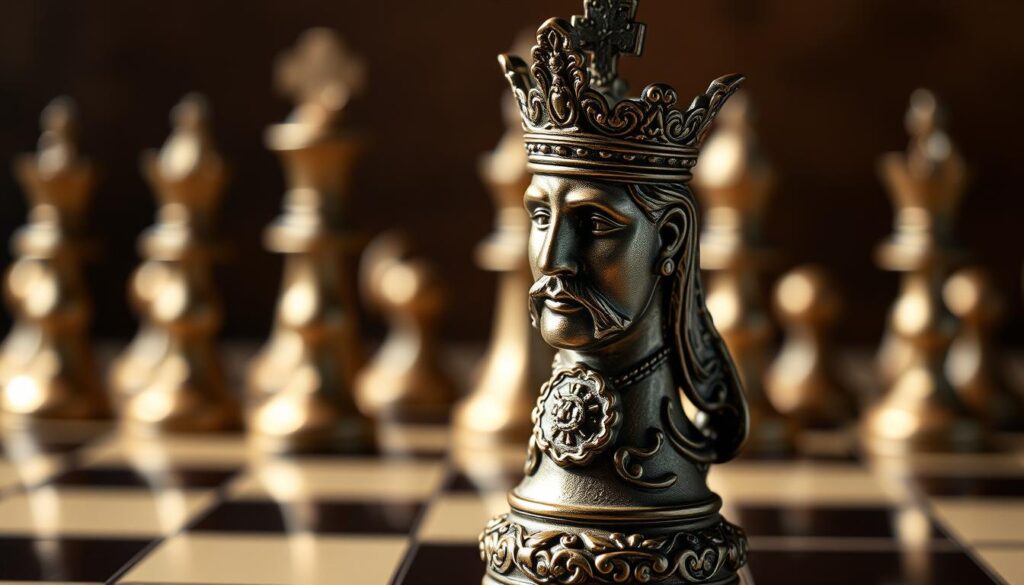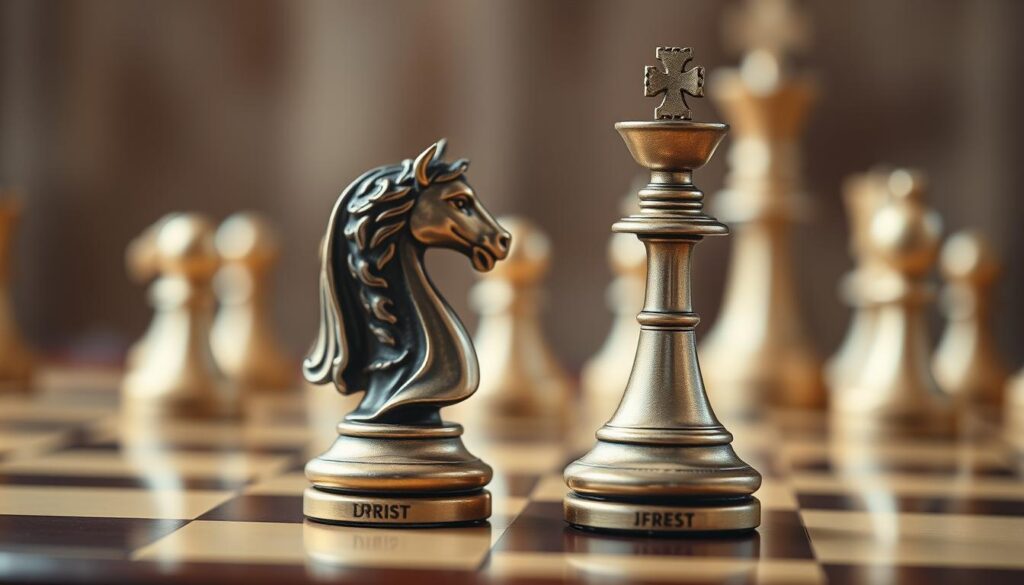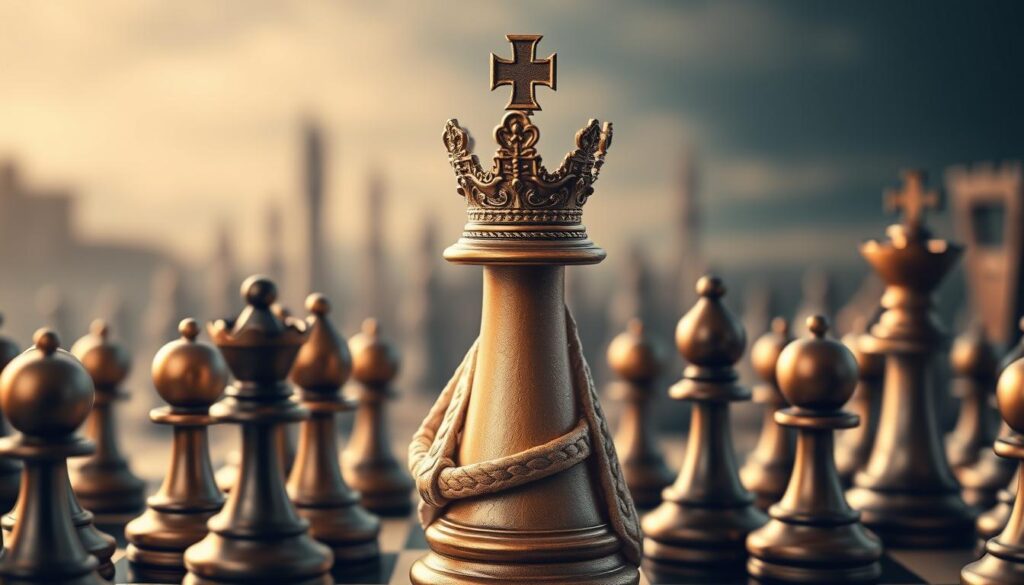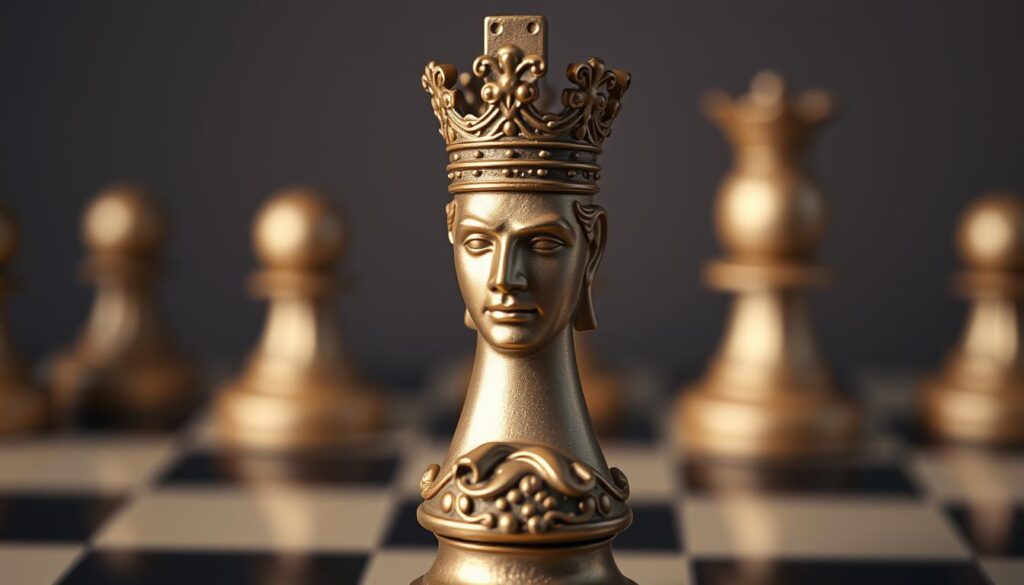When you play chess, you know the king is key. Keeping the king safe is crucial. You’re about to learn how to master the king piece and become a better chess player.
Knowing how the king moves and stays safe is important. The king can’t move much, but it’s vital for winning. You’ll learn how to protect your king and use it to your advantage.
Table of Contents
Understanding the King Chess Piece’s Role
The king piece chess is the most vital piece in the game. Its protection is key to success. The king chess figurine has unique traits that make it stand out. It has a rich history and plays a crucial role in the game’s strategy.
The king’s basic characteristics and value are important to know. It can move one square in any direction. This makes it slow and vulnerable. Yet, its importance is huge, as the game’s goal is to protect the king and checkmate your opponent’s.
The King’s Significance in Chess
The king’s role in chess is complex. It’s the most important piece and determines the game’s outcome. If your king is checkmated, you lose. But, if you protect your king and checkmate your opponent’s, you win.
Basic Characteristics and Value
Here are some key traits and values of the king piece chess:
- Movement: The king can move one square in any direction (horizontally, vertically, or diagonally).
- Value: The king’s value is infinite, as losing it means losing the game.
- Protection: The king must be protected at all costs, as its loss determines the game’s outcome.
Historical Evolution of the King
The king chess figurine has changed a lot over time. From ancient India to today, it’s remained crucial in chess. Knowing its history helps us understand its importance and role in the game.

As you learn more about chess, you’ll see the king is more than just a piece. It’s a complex, strategic element that needs careful thought and protection.
| Characteristics | Description |
|---|---|
| Movement | The king can move one square in any direction (horizontally, vertically, or diagonally). |
| Value | The king’s value is infinite, as losing it means losing the game. |
| Protection | The king must be protected at all costs, as its loss determines the game’s outcome. |
Essential Movement Rules for the King
When you start playing chess, knowing how the king moves is key. The king can move one square in any direction. This means it can go left, right, up, down, or diagonally. Even though the king can’t move far, its movements are crucial to the game.
The king can also capture pieces by landing on the square next to them. This makes the king very powerful, even with its limited range. Let’s look at how the king moves:
- The king can move one square in any direction (forward, backward, sideways, or diagonally).
- The king can capture any opponent’s piece standing on an adjacent square.
- The king is the only piece that cannot be captured, as the goal of the game is to protect it and checkmate your opponent’s king.
It’s important to remember that the king’s movement is not just about capturing pieces. It’s also about staying safe from your opponent’s attacks. The king is a vital part of the game. Knowing how it moves is essential for becoming a good chess player.

By learning the king’s movement rules, you’ll get better at playing chess. Remember, the secret to winning is understanding the king’s special abilities and limits.
The Art of King Safety in Chess
As you explore chess, learning to protect your king is crucial. The king is the most valuable piece, and keeping it safe is key to winning. We’ll look at how to keep your king safe, from the start of the game to the middle.
Keeping your king safe means watching how close your pieces are to it. Try to keep your king behind pawns, early on. This stops your opponent from attacking your king. Also, watch out for open paths for your opponent’s pieces to reach your king.

- Not castling early enough, leaving your king exposed in the center of the board
- Not paying attention to your opponent’s pieces, allowing them to launch a surprise attack on your king
- Not using your pawns to block attacks on your king, leaving it vulnerable to checkmate
By following these tips, you can boost your chances of winning at chess. Remember, your king is the most important piece. Keeping it safe is essential for success.
Castling: Your King’s Special Move
As you explore chess, you’ll find the king’s special move, castling. It lets the king move three squares towards a rook. The rook then moves to the square the king crossed. This move is key for keeping the king safe and can greatly improve your chances of winning.
The rules for castling are simple. The king and rook must not have moved before, and there can’t be pieces in between. Also, the king can’t be in check or pass through an attacked square. Castling has been a chess staple since the 1500s, becoming a crucial strategic tool.
Understanding Castling Techniques
To master castling, you need to know the different types. Kingside castling moves the king to the g-file, while queenside moves it to the c-file. The success of castling depends on the king and rook’s correct positioning and the absence of obstacles.

When to Castle
Knowing when to castle is crucial. It can protect the king, bring the rook into play, and open up attack opportunities. But, it’s not always the best choice. Players must weigh the board’s position before castling. Mastering castling can enhance your chess strategy and boost your winning chances.
| Type of Castling | King Movement | Rook Movement |
|---|---|---|
| Kingside Castling | King moves to g1 (White) or g8 (Black) | Rook moves to f1 (White) or f8 (Black) |
| Queenside Castling | King moves to c1 (White) or c8 (Black) | Rook moves to d1 (White) or d8 (Black) |
The King Chess Piece in Endgame Scenarios
When you reach the endgame, the king chess figurine becomes a key player. It can move one square in any direction. This makes it very useful in the endgame, working well with pawns.
The royal chess piece can trap an opponent’s king. This leads to quick pawn promotion and a win. It’s a powerful move.
In the endgame, the king is much stronger than in the start or middle of the game. Its moves can greatly affect the game’s outcome. Here are some important facts:
- In king and pawn endings, an extra pawn decides the game more than 90% of the time.
- With pieces and pawns, an extra pawn wins in 50% to 60% of the cases.
The king helps passed pawns a lot in the endgame. Knowing how the king works in the endgame helps you win. With smart moves and a well-placed king chess figurine, you can win the game.
Advanced King Activation Strategies
Improving your chess skills means mastering advanced king activation strategies. The king chess piece is key in the endgame. Moving your chess king to the board’s center boosts its power and helps win games.
Knowing when to use your king aggressively is crucial. You need to read the board and find the right time to move your king. This action can put pressure on your opponent and open up attack chances.
Some top strategies for king activation include:
- Creating opposition: This means placing your king to block your opponent’s moves.
- Targeting weak pawns: Activating your king lets you attack weak pawns, creating strong passed pawns.
- Controlling key squares: Your king can guard important squares, making it hard for your opponent to attack.
Mastering these strategies can greatly boost your win rate. Always think about the board and adjust your plan as needed. With more practice, you’ll get better at using your chess king to win.
| Strategy | Description |
|---|---|
| Creating opposition | Positioning your king to gain opposition and limit your opponent’s movement |
| Targeting weak pawns | Using your king to target weak pawns and create passed pawns |
| Controlling key squares | Using your king to control key squares and limit your opponent’s attack |
Protecting Against Common King Attacks
As you play chess, keeping your king safe is key to winning. The king is the most important piece, and its safety comes first. To defend against common attacks, knowing your opponent’s tactics is crucial.
Watch out for Scholar’s Mate, a common checkmate pattern. Knowing this tactic helps you avoid it and keep your king safe. Also, discovered attacks are dangerous, as they use a piece to attack your king while revealing a stronger piece behind it.
- Control the center of the board to limit your opponent’s mobility and reduce the risk of attack.
- Maintain a strong pawn structure in front of your king to provide an extra layer of protection.
- Be cautious of pieces that can potentially fork or skewer your king, and take steps to prevent these tactics.
Understanding and defending against common king attacks can greatly improve your chess game. Always keep your king safe and adjust your strategy as the game changes.
| Attack Type | Defense Strategy |
|---|---|
| Scholar’s Mate | Avoid weak pawn structures and control the center |
| Discovered Attack | Anticipate and prevent the attack by moving pieces to safe squares |
King and Pawn Endgames Mastery
Mastering king and pawn endgames is key to winning at chess. The noble chess king is vital in these situations. Learning to use it well can greatly boost your chances of winning.
Using connected pawns can lead to a win about 99% of the time. This shows how crucial practice and strategy are. Also, having a 2-pawn advantage can help you draw, depending on your opponent’s moves.
Some important endgame strategies include:
- Understanding the “square” and its impact on pawn promotion
- Using one pawn to support another in disconnected pawn scenarios
- Keeping control over queening squares, mainly in rook pawn endgames
By mastering king and pawn endgames, you can enhance your chess skills. Focus on the noble chess king and practice your strategies. This will make you a better chess player.
| Endgame Scenario | Winning Percentage |
|---|---|
| Connected Pawns | 99% |
| 2-Pawn Advantage | Varies |
| Rook Pawn Endgames | Depends on King Position |
Famous Games Showcasing King Strategy
Exploring chess, you’ll find many famous games that highlight king strategy. The king piece chess is key in these games. Knowing how to move and protect it is crucial for winning.
The 1985 World Chess Championship between Anatoly Karpov and Garry Kasparov is a great example. Kasparov’s king chess figurine was crucial in his win. Another famous game is the “game of the century” in 1956 between Bobby Fischer and Donald Byrne. It showed Fischer’s talent at a young age.
Here are a few more examples of famous games that demonstrate effective king strategy:
- The 1858 match known as “The Opera Game” between Paul Morphy and two opponents, which lasted only 17 moves.
- The historic match of Kasparov vs. Topalov, which involved pivotal moves during a king hunt scenario.
- The 1991 match between Nigel Short and Jan Timman, which featured consecutive king moves resulting in a checkmate scenario.
By studying these famous games, you can learn a lot about king strategy in chess. It will help you improve your skills with the king piece chess.
Conclusion: Maximizing Your King’s Potential
Learning to master the chess piece king is key to winning at chess. You’ll understand how it moves, stay safe, and use it to attack. This way, the king chess piece becomes more than just a defender. It can be a strong attacker too.
This guide has covered the king’s role from its history to its importance in the endgame. The king’s job isn’t just to protect early on. It can also be a strong ally in the middlegame and endgame. It helps with pawn promotion, works with other pieces, and can even win the game.
Use king safety, castling, and advanced tactics to improve your chess. Learning the king’s skills will help you handle tough games and beat your opponents. Keep practicing and learning, and you’ll see how the king can change your chess game.
FAQ
What is the significance of the king chess piece?
The king is the most important piece in chess. Its role can greatly affect the game’s outcome. Knowing how to move and protect the king is key for any player.
How does the king chess piece move?
The king moves one square in any direction. It’s the least mobile piece but crucial for the game’s flow.
What are the strategies for king safety in chess?
Keeping the king safe is vital in chess. Players must learn to protect it early on and position it well in the middle game. Avoiding common mistakes is also important.
What is castling, and how does it benefit the king?
Castling lets the king move three squares towards a rook while the rook moves to the king’s square. It’s key for keeping the king safe and can boost winning chances.
How does the king chess piece influence endgame scenarios?
In endgames, the king’s movement and safety are crucial. Mastering its role in these scenarios is essential for success.
What are some advanced strategies for activating the king?
Advanced strategies involve using the king aggressively to win. This includes knowing when to attack, using king opposition tactics, and creating winning positions.
How can I defend against common king attacks?
Defending against attacks like Scholar’s Mate and discovered attacks is key. Understanding these techniques can significantly improve your chances of winning.
What are the key strategies for mastering king and pawn endgames?
Mastering king and pawn endgames is crucial for success. Strategies for success and avoiding common mistakes are essential in these phases.
Can you provide examples of famous games showcasing king strategy?
Looking at historical and modern games can offer insights into king strategy. These examples highlight the king’s strategic value in chess.




